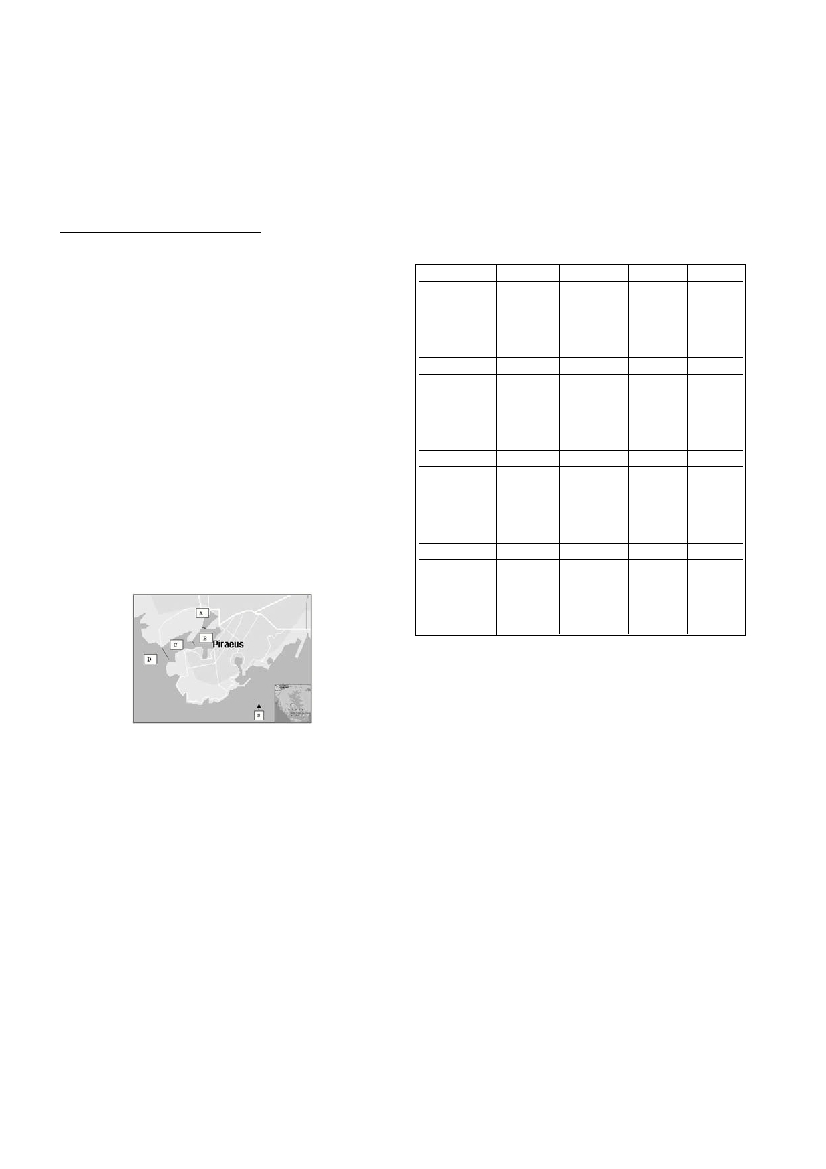Rapp. Comm. int. Mer Médit., 36,2001
161
Introduction
Piraeus port is considered as the third most frequent passenger port in the
world and the leading container hub in the Eastern Mediterranean. Its main
port areas are a central passenger port, a container terminal, a commercial
port, and a ship repair and maintenance site. Previous studies of Piraeus port
have shown high values of dissolved metals (Fe, Zn, Pb, Cu, Ni, Mn) indi-
cating the relatively poor seawater quality in the area studied [1].
In the present paper metal partitioning among the various geochemical
phases of the sediments is examined by sequential chemical ex
traction
which, although a time consuming technique, can provide detailed infor-
mation concerning the source, mode of occurrence, biological and phy
sico-
chemical ava
ilability, mobilization and uptake of metals in sediments [2].
Methodology
Twenty-five surface sediment samples from various locations of the
Piraeus port (Fig.1) were collected during three annual cruises (1997,1998,
1999). The total metal content (Pb, Fe, Cu, Zn) was measured after treat-
ment of the samples by a mixture of concentrated HNO3, HClO4, HF at
high temperature [3]. The partitioning of the metals was examined follow-
ing the Tessieret al(1979) procedure [4] with some modifications [5]. Pb,
Fe, Cu and Zn were examined within five fractions, the following:
exchangeable (E), (1M NH
4
OAc, pH 8.2) ; carbonate associated (C), (1M
NaOAc, pH 5) ; reducible (Red), (0.04M NH
2
OH.HCl, pH 2) ; organic
matter-sulphide bound (Ox+Sul), (HNO
3
, 30% H
2
O
2
, NH
4
OAc) and resid-
ual (Res).
All metal concentrations were measured by Atomic A
b
s
o
r
p
t
i
o
n
Spectrophotometry.The relative standard deviation of the measurements,
which was obtained from the analysis of five discrete subsamples of select-
ed samples was <5%.
Figure 1 : The Piraeus port with the studied areas.
Results and
Discussion
From the results of Table 1 the following conclusions are drawn:
?The total metal content shows an enrichment in area C that can be
attributed to the presence of the ship repair and maintenance site of the
port.
?Cu and Zn show significant percentages in the exchangeable fraction,
indicating that they can be easily released.
?All metals show very small percentages present in the carbonate bound
fraction, which represents sedimentary carbonates, mainly calcium car-
bonate.
?Pb, Fe and Zn show significant percentages in the reducible fraction,
which represents metals bound to ferromanganese oxides.
?Pb, Fe, Zn and especially Cu show significant percentages in the organ-
ic/sulphide fraction indicating their association with the organic matter
and/or sulphide minerals.
?The major percentages of Pb, Fe and Zn and a significant percentage of
Cu are found to the residual fraction as they are bound in the lattice struc-
ture of aluminosilicate minerals.
?In area D, some extreme values (Fe >200,000 µg/g, Zn >6,000 µg/g) ,
not included in the Table 1, were found in restricted areas in the vicinity of
industrialized sites (cement and fertilizer manufacturing).
References
1 - Sakellariadou F., Dassenakis M., Michailidou L., Haralambides L., 1999.
Metal pollution in Piraeus port, a major Mediterranean port. 10
th
International
Symposium of MESAEP Alicante, Spain, Abstracts , p. 120.
2 - Quevauviller P., Rauret G., Griepink B., 1993. Conclusions of the
workshop: Single and sequential extraction in sediments. Int. J. Env.Anal.
Chem., 51, 1–4, 231–235
3 - UNEP, 1985. Reference Methods for Marine Pollution Studies, No 31-39.
4 - Tessier A., Campbell, P.G.C. and Bisson M., 1979. Sequential extraction
procedure of the speciation of particulate trace metals. Anal. Chem., 51, 7,
844-850.
5 - Sakellariadou F., 1987. Geochemistry of nearshore sediments from the
North Aegean Sea, Greece. Ph.D. Thesis, Imperial College, London, p. 376.
METAL PARTITIONING IN PIRAEUS PORT SEDIMENTS
F.Sakellariadou
1*
, L.Haralambides
1
, M.Dassenakis
2
1
Department of Maritime Studies, University of Piraeus, Greece - fsakelar@unipi.gr
2
Department of Chemistry, University of Athens, Greece - edasenak@cc.uoa.gr
Abstract
The metal partitioning among the geochemical phases of sediment samples from the Piraeus port was studied. It shows a total metal
enrichment close to the ship repair and maintenance site of the port. Copper and Zn show significant bioavailability. Significant proportions
of Pb, Fe and Zn are bound to ferromanganese oxides. Lead, Fe, Zn and especially Cu are highly associated with the organic and sulphide
fraction. The major percentages of Pb, Fe and Zn are found to the residual fraction as they are bound in the lattice structure of
aluminosilicate minerals.
Keywords : sediment, metals, zinc, lead.
AreaA
Pb
Fe
Cu
Zn
Total (µg/g)56-37412619-1805587-270720-925
E (%)
<1
<112-336-20
C (%)
0-7
<1
1-4
0-4
Red (%)18-449-15
1-412-22
Ox+Sul (%)5-2017-2438-583-10
Res (%)35-7064-7424-4445-74
Area B
Total (µg/g)217-46414175-20541173-305700-1090
E (%)
0-1
<117-259-16
C (%)
1-3
<1
1-3
1-4
Red (%)13-489-15
0-310-20
Ox+Sul (%)4-1717-3443-594-10
Res (%)33-8156-7019-3453-75
Area C
Total (µg/g)449-74924869-64429291-8671059-2403
E (%)
0-1
<115-2310-14
C (%)
1-5
<1
1-5
2-4
Red (%)24-398-12
0-313-20
Ox+Sul (%)11-208-2649-656-10
Res (%)39-6362-8415-2556-66
Area d
Total (µg/g)279-39011600-20250160-4081200-1605
E (%)
<1
0-115-256-18
C (%)
1-3
<1
1-2
1-4
Red (%)18-4214-180-311-31
Ox+Sul (%)9-4219-4050-725-14
Res %
25-7246-6412-2239-73
Table 1. Metal content in total sediment and percentages in

